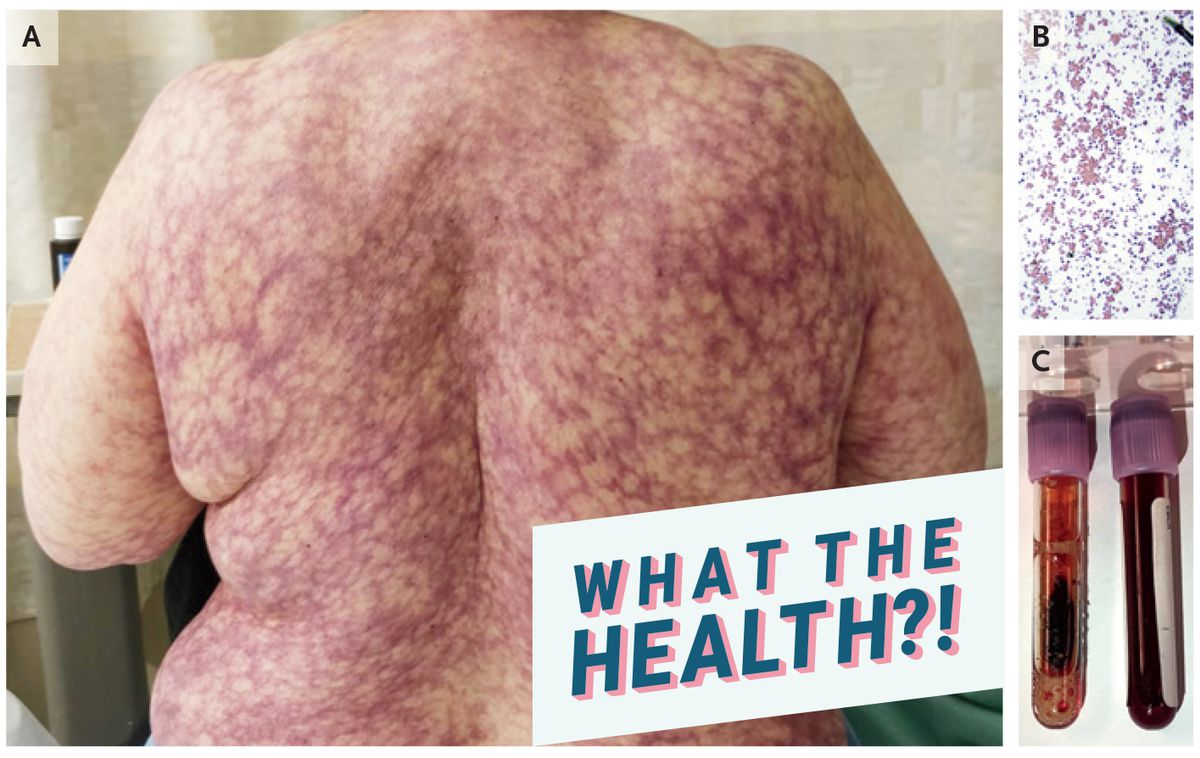Common colds can cause complications like an ear infection or bronchitis. But a viral respiratory tract infection turned into something much scarier for a 70-year-old woman featured in a new case report published today in the New England Journal of Medicine.
The woman went to an outpatient clinic after a dark red, purplish rash broke out all over her back. The rash showed up after she had a viral respiratory tract infection. Aside from the generalized rash, the patient had also been experiencing dizziness for about a week.
That generalized rash also has a name: livedo reticularis. It's described by the US National Library of Medicine as a "netlike pattern of reddish-blue skin discoloration," and it's linked to swollen blood vessels. The USNLM says that the rash can get worse as the temperature drops.
After tests were run, the patient was diagnosed with a rare condition called cold agglutinin disease, which causes the body to mistakenly attack and destroy red blood cells, according to the Genetic and Rare Diseases Information Center (GARD), a division of the National Institutes of Health.
The case report acknowledged that the condition could have been exacerbated by the patient’s recent respiratory tract infection. It also noted that the cold weather in upstate New York at the time of the incident (15 degrees Fahrenheit) could have been responsible for the rash that covered the patient’s back.
RELATED: What is Methemoglobinemia? What to Know About the Rare Disorder That Turned One Woman’s Blood Blue
What is cold agglutinin disease?
Cold agglutinin disease is a type of autoimmune hemolytic anemia (AIHA), which causes a person’s immune system to harm red blood cells. According to GARD, symptoms of the disorder include tiredness, headaches, dizziness (which the patient in the new case report experienced), cold feet and hands, and jaundice, which is a condition that can cause the skin or eyes to appear yellow. Additionally, cold agglutinin disease can cause heart problems, including an irregular heartbeat, and enlarged heart, a heart murmur, or even heart failure.
When a person with the disorder is exposed to temperatures under 50 degrees Fahrenheit, proteins that usually attack bacteria can instead attach themselves to the person’s red blood cells. Those proteins bind the red blood cells into clumps, which is called agglutination (see it in the picture labeled "C" above, where particles of her blood are clumped together in the left tube). Eventually, this causes the red blood cells to be destroyed, which can lead to anemia, the technical term for a lack of red blood cells. (FYI: Red blood cells are important, since they carry oxygen to your body's tissues.)
Cold agglutinin disease cases are divided up into two categories: primary and secondary. For people with primary cold agglutinin disease, the cause of the condition is unknown. Secondary cold agglutinin disease can be caused by an underlying condition (for example, an infection), certain cancers, or another autoimmune disease. Cold agglutinin disease cannot be inherited, according to GARD.
RELATED: This Girl’s Toe Turned Purple from Millipede Staining—Here's What That Means
Several tests can help doctors diagnose patients with cold agglutinin disease, including blood tests, which the patient in the new case report underwent, and a physical examination.
How the condition is treated depends on a number of factors, including the underlying cause of the illness, the patient’s symptoms, and the severity of the illness. For example, if the condition is secondary, doctors will need to get to the bottom of what's causing it and potentially treat that. Some people, on the other hand, might not require treatment. For some, treatment involves simply avoiding the cold, according to GARD.
Luckily, people like the patient in the new case report who suffer from cold agglutinin disease on the heels of a viral infection “tend to have an excellent prognosis,” GARD explains. Specifically, their symptoms usually disappear within the six months after their infection cleared.
The case report says the patient featured in it was warmed up and treated with rituximab (a drug that treats some cancers and autoimmune diseases) and blood transfusions. While her dizziness subsided, her rash remained with her, according to the case report.
To get our top stories delivered to your inbox, sign up for the Healthy Living newsletter
